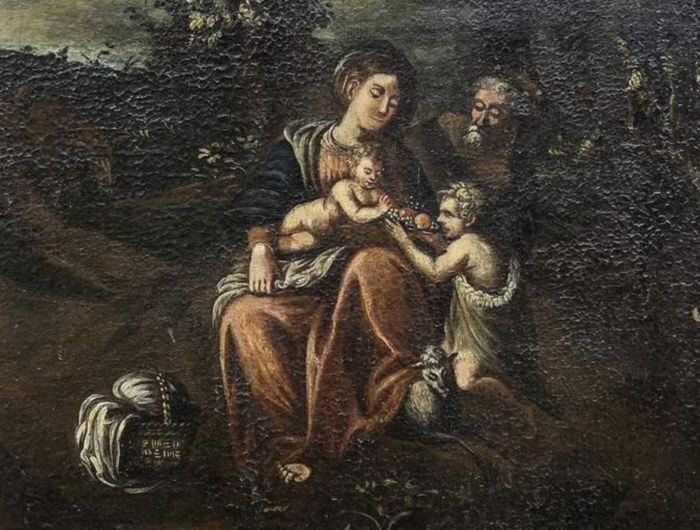Scuola Lombarda del XVII secolo - Sacra Famiglia
The canvas measures 39. 5 x 51 cm and the gilded and painted wooden frame 72. 5 x 84. 5 cm. The scene depicts a beautiful Holy Family in the style of the Lombard School from the first half of the 17th century. In Christian doctrine, the expression Holy Family refers to the family of Jesus, consisting of Jesus Himself, Mary and Joseph. In the Gospel of Matthew, after the adoration of the Magi, an angel warns Joseph to flee to Egypt because Herod wants to kill Jesus; the holy family will then remain in Egypt until the death of the king, who had ordered to kill all the male newborns of Bethlehem in the vain intent to get rid of Jesus. When Herod died, the holy family returned to Nazareth. In the Gospel of Luke we find instead the episode of the circumcision of the child according to the law of Moses, the loss and finding of the twelve-year-old Jesus in the temple of Jerusalem; found after three days of searching, the holy family returned to Nazareth, where Jesus grew up submissive to his parents. The Lombard Baroque experience can be divided into three parts: the early seventeenth century, the late seventeenth century and the eighteenth century. The early seventeenth century began with the appointment as bishop of Milan of Federico Borromeo in 1595 in continuity with the work of his cousin Carlo: in this first phase the main exponents of Milanese painting are three: Giovan Battista Crespi (also known as Cerano) , Giulio Cesare Procaccini, and Pier Francesco Mazzucchelli (known as Morazzone) . In this first phase, the evolution of the new Baroque style follows with continuity the late Mannerist art widespread in Milan at the time of Carlo Borromeo; the training of the three painters took place on the models of late Tuscan and Roman Mannerism for Cerano and Morazzone, while Procaccini was formed on Emilian models. With certificate of authenticity and lawful origin issued by our gallery, with photo as required by the law. Safe and tracked shipping. The coeval frame is offered as a gift, so we do not accept any claims and are not responsible for any damages during transport.
[ translate ]View it on
Estimate
Time, Location
Auction House
The canvas measures 39. 5 x 51 cm and the gilded and painted wooden frame 72. 5 x 84. 5 cm. The scene depicts a beautiful Holy Family in the style of the Lombard School from the first half of the 17th century. In Christian doctrine, the expression Holy Family refers to the family of Jesus, consisting of Jesus Himself, Mary and Joseph. In the Gospel of Matthew, after the adoration of the Magi, an angel warns Joseph to flee to Egypt because Herod wants to kill Jesus; the holy family will then remain in Egypt until the death of the king, who had ordered to kill all the male newborns of Bethlehem in the vain intent to get rid of Jesus. When Herod died, the holy family returned to Nazareth. In the Gospel of Luke we find instead the episode of the circumcision of the child according to the law of Moses, the loss and finding of the twelve-year-old Jesus in the temple of Jerusalem; found after three days of searching, the holy family returned to Nazareth, where Jesus grew up submissive to his parents. The Lombard Baroque experience can be divided into three parts: the early seventeenth century, the late seventeenth century and the eighteenth century. The early seventeenth century began with the appointment as bishop of Milan of Federico Borromeo in 1595 in continuity with the work of his cousin Carlo: in this first phase the main exponents of Milanese painting are three: Giovan Battista Crespi (also known as Cerano) , Giulio Cesare Procaccini, and Pier Francesco Mazzucchelli (known as Morazzone) . In this first phase, the evolution of the new Baroque style follows with continuity the late Mannerist art widespread in Milan at the time of Carlo Borromeo; the training of the three painters took place on the models of late Tuscan and Roman Mannerism for Cerano and Morazzone, while Procaccini was formed on Emilian models. With certificate of authenticity and lawful origin issued by our gallery, with photo as required by the law. Safe and tracked shipping. The coeval frame is offered as a gift, so we do not accept any claims and are not responsible for any damages during transport.
[ translate ]


